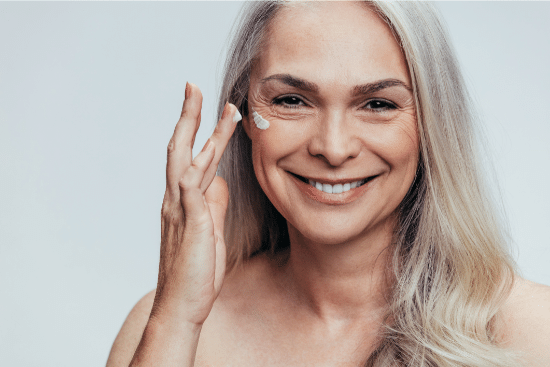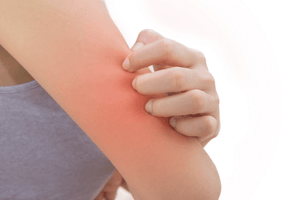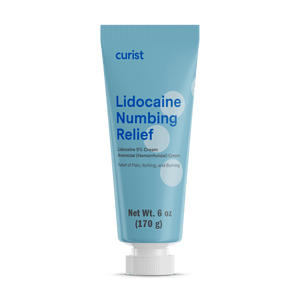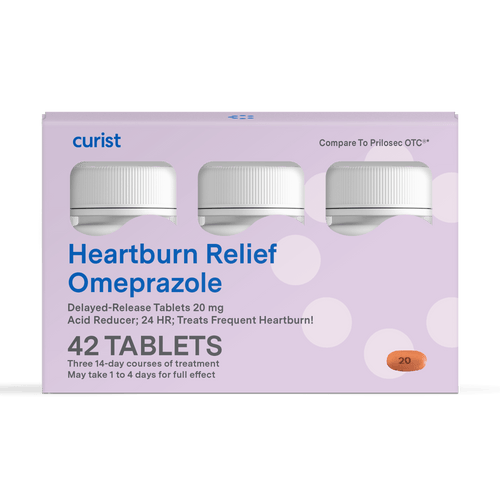By Dr. Allison Dinh, PharmD, Curist Pharmacy Advisor
Curist delivers over-the-counter medicines to your door at a fraction of the price of traditional brands. We hope everyone stays safe and healthy during this time.
Adapalene is known to be used for treating acne, but did you know that it also has anti-aging benefits? Continue to read below about this holy grail ingredient touted by dermatologists and skincare experts!
Collagen, Elastin & Glycosaminoglycan: Why Does Skin Age?
As people grow older, their skin naturally loses its youthful look over time due to a combination of decreases in collagen, elastin, and glycosaminoglycans as well as changes in exfoliation.
Skin Aging Due to Collagen
Collagen is a protein responsible for the firmness and structure of the skin. Though collagen is commonly associated with the skin, it is also found in the bones as well. Your body naturally makes collagen from amino acids but it can also be ingested in the form of powder supplements. Decreases in collagen production with age lead to thinner, less firm skin in comparison to one’s younger years. In fact, it has been estimated that once you hit your 20s, you lose about 1% of collagen each year. That is an approximate 10% loss by the time someone is age 30!
Skin Aging Due to Elastin
Elastin is another type of protein found in the body. As its name eludes, it brings elasticity and stretchiness to the skin. Its purpose is to give the skin its ability to retain its shape after being stretched. Decreased elastin means that the skin does not bounce back as easily as it did before. For example, if you were to pinch the skin and then release it on the average 80-year-old skin versus 20-year-old skin, the former would take longer to return to the baseline state because of different elastin levels.
Skin Aging Due to Glycosaminoglycan
Glycosaminoglycans are complex carbohydrates that play a key role in skin hydration. These molecules bind water and give skin a youthful, hydrated glow. With fewer glycosaminoglycans, the skin is prone to becoming drier and more dehydrated in comparison. That is why continuing to drink plenty of water is so important!
Aging skin is nothing to be ashamed of! As mentioned, it is natural and to be expected over the lifespan. What is important to note is that there are ways to mitigate aging effects from external factors (such as the sun or pollution) if you wish to do so!
Signs of Aging Skin: Wrinkles vs Fine Lines vs Hyperpigmentation
Unfortunately aging skin can take many different forms. Here’s a comparison of the most common types of aging skin, wrinkles vs fine lines vs hyperpigmentation.
Aging Skin: Wrinkles
Wrinkles is often the buzzword whenever the topic of aging is concerned. This term refers to visible lines, creases, or folds in the skin. Some common areas of the face where wrinkles can present are the forehead (“11”, referring to the two parallel lines that may appear), corners of the eyes (“crow’s feet”), and around the mouth (“smile lines”).
Aging Skin: Fine Lines
Fine lines are shallower lines on the face and are not as deep-set as wrinkles. Often, these can be found underneath the eyes. Even though fine lines are not full-fledged wrinkles, they can become wrinkles with time.
Aging Skin: Hyperpigmentation
Hyperpigmentation can be another feature of aging skin. There are different types of hyperpigmentation, but the kind that is associated with aging is dark spots. They are also known as sun spots, or more colloquially, liver spots. The more medical term is solar lentigines. As the name suggests, these darkened patches of skin are caused by sun exposure. Hyperpigmentation is largely harmless, but individuals often want to treat dark spots to achieve a more even-looking skin tone.
What is the Difference Between Aging vs Photoaging?
As we have discussed, aging is normal and a number of intrinsic factors contribute to the skin’s aging appearance. However, extrinsic or outside causes can also add to, or even accelerate the aging process. One prime culprit is the sun itself.
Photoaging is aging that is induced by UV light exposure. UV light penetrates through the skin and disrupts DNA at the cellular level, prematurely aging the skin. Furthermore, this DNA damage increases the risk of developing skin cancer.
All unprotected skin is susceptible to photoaging, but not everyone will be affected equally. Skin tone and geographic location affect one’s risk. In general, people with lighter skin and those living closer to the equator are more prone to photoaging.
How Can I Prevent Skin Aging?
Even though aging is a natural part of growing older, there are ways to slow down the process and prevent some of the telltale signs.
Sunscreen to Prevent Skin Aging: Physical Sunscreen vs Chemical Sunscreen
Sunscreen isn’t just for summer and the beach. You should be wearing sunscreen every day in fact! Sunscreen protects your skin from UV damage from the sun, thereby preventing photoaging. There are two main types of sunscreens: physical sunscreens and chemical sunscreens. Physical sunscreens, also known as mineral sunscreens, contain ingredients such as zinc oxide and titanium dioxide that rest on top of the skin to reflect the sun’s rays. Conversely, chemical sunscreens are absorbed into the skin and work by transforming the UV rays into heat or a wavelength of light that is not damaging to the skin. On top of photoaging prevention, sunscreens are great at preventing skin cancers such as melanoma and basal cell carcinoma. Aim for a sunscreen with an SPF of at least 30 and reapply every 2 hours if you are out in the sun. If the sun bothers your skin in other ways, like sun rash, please learn more with the Curist article Sun Allergies vs Sun Poisoning vs Solar Urticaria.
Cover Yourself from the Sun to Prevent Skin Aging
Covering up your skin will block exposure to UV rays and therefore mitigate its damage. There are a variety of different accessories you can wear. For the face, sunglasses and wide-brimmed hats are helpful. For the body, you can’t go wrong with long-sleeved shirts and pants. While driving, you can even wear gloves to prevent premature aging of the skin on your hands.
Don’t Go Tanning to Prevent Skin Aging
Many people want to get the sun-kissed glow of a tan, but the tanning bed should not be the way to get it. Whether you get a tan from the salon or outside, tanning itself ages the skin. Therefore, it’s best to use a self-tanning spray or lotion to achieve a bronzed look.
Stop Smoking to Prevent Skin Aging
It’s known that smoking is dangerous for the lungs, but it is also harmful to the skin. Firstly, smoking quickens the aging process and contributes to premature wrinkles and a duller skin tone. Additionally, tobacco smoke contains several carcinogens that disrupt skin elasticity and dries out the skin. Furthermore, constantly pursing the lips around a cigarette can lead to fine lines around the mouth.
Stay Hydrated to Prevent Skin Aging
Make sure to drink plenty of water every day to ensure that your skin gets the moisture and hydration it needs. Indeed, water makes up a large portion of your body–around 50% to 70% of your body weight! If you are hydrated or dehydrated, your skin will be a reflection of that.
What Anti-Aging Ingredients Should I Add to My Skincare Routine?
Consider using creams or serums that contain anti-aging ingredients or using OTC products to augment your routine. There are a plethora of beneficial skincare ingredients, but some that we will touch upon are retinoids, alpha hydroxy acids (AHAs), and vitamin C. Retinoids, such as retinol, tretinoin, and adapalene, are vitamin A derivatives that have been studied to be effective agents for combating wrinkles. AHAs include glycolic acid, citric acid, and lactic acid. They are great for exfoliation to remove dead skin cells. Vitamin C is an antioxidant and thereby protects against free radicals, molecules that cause skin damage. However, vitamin C and AHAs should not be used together because AHAs will disrupt the pH balance of vitamin C. Whichever ingredient(s) you choose, be sure to consult a dermatologist to develop a regimen and get your skin thoroughly checked.
What is Adapalene? Is Adapalene Good for Anti-Aging?
As mentioned, adapalene is an ingredient found in a number of skincare products. It is a retinoid that is used topically on the skin to treat acne by preventing clogged pores from forming. Retinoids are vitamin A derivatives that boast a number of benefits, such as reducing hyperpigmentation and fine lines. Therefore, adapalene is often used for anti-aging as well. There are prescription and over-the-counter forms of adapalene, depending on the strength.
Adapalene employs several actions on the skin that promote its anti-aging effects. It increases skin cell turnover, which promotes and helps to exfoliate the skin. Altogether, this prevents the build-up of older skin to let the newer skin shine through. See the Curist article Adapalene vs Tretinoin vs Retinol vs Benzoyl Peroxide to learn more about adapalene.
How Do I Take Adapalene for Anti-Aging?
Adapalene is applied once a day topically to the skin on the face. This application can be anytime during the day, either in the morning or at night. Before applying adapalene, you first need to cleanse your face and allow it to dry. Then, you will take a pea-sized amount of adapalene from the tube. Spread it in a thin layer on your entire face, taking care to avoid the eyes and lips. That may seem like too small of an amount, but that is all that you will need! Any more than that would be too irritating to the skin. When it comes to skincare, less is more.
How Long Will Adapalene Take to Work for Anti-Aging and Show Results?
Patience and regular use is key – smooth skin will not happen overnight! It takes around 8 to 12 weeks to see the adapalene work on your skin and start to see results. Furthermore, your skin may go through a stage where it is initially irritated before the smoothening effects kick in. Fortunately, this is temporary.
Can Adapalene Be Used by Everyone?
Adapalene is FDA-approved for patients of age 12 years and older. However, certain patient populations should avoid adapalene. Pregnant women or women who are planning on becoming pregnant are recommended to not use adapalene due to a potential risk to the fetus. Additionally, women who are breastfeeding should be cautioned against using adapalene. In non-pregnant and non-breastfeeding individuals, adapalene should be fairly safe.












